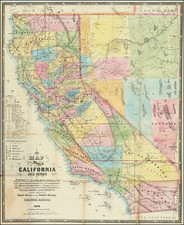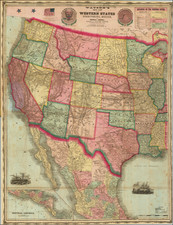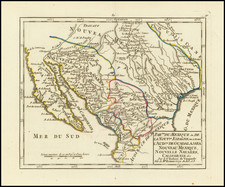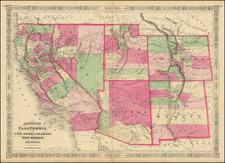Fine early view of the Albuquerque, New Mexico, one year after the incorporation of the City in 1885, drawn by Augustus Koch, one of America's most prolific birdseye view makers.
The view depicts Albuquerque from the East with the Rio Grande River and the New Mexico Fair Association Grounds in the background and centered on the Atlantic & Pacific Railroad Grounds (including offices, round house, repair shops, etc.) and Union Passenger Depot and Union Freight Depot, hotels, Mills, and Albuquerque's first Brewery.
Albuquerque was founded in 1706 as the Spanish colonial outpost of Ranchos de Alburquerque. Albuquerque was a farming community and strategically located military outpost along the Camino Real. The town was also the sheep-herding center of the West. Spain established a presidio in Albuquerque in 1706. After 1821, Mexico also had a military garrison there. After the American occupation of New Mexico, Albuquerque had a federal garrison and quartermaster depot, the Post of Albuquerque, from 1846 to 1867. During the Civil War Albuquerque was briefly occupied in February 1862 by Confederate troops under General Henry Hopkins Sibley.
When the Atchison, Topeka and Santa Fe Railroad arrived in 1880, the Railroad bypassed the old Spanish Plaza, locating its passenger depot and railyards about 2 miles east in what quickly became known as New Albuquerque or New Town. Many Anglo merchants, mountain men, and settlers moved into Albuquerque, transforming the town into a significant commercial hub the southwest. The present view shows Albuquerque shortly after its birth as a city in 1885, with a number of the earliest commercial enterprises illustrated in the image.
Augustus Koch began his career as an itinerate birdseye view artist in California in 1870. Over the next nearly 30 years, he would criss-cross the country, creating more than 100 views of towns, large and small. His large format, highly detailed views are among the most coveted among collectors, employing a unique style which provides both physical detailed of the town and a map-like quality,
The view is apparently very rare. We located an uncolored example in the Robert B. Honeyman Jr. Collection (Bancroft Library), which did not include the blue tint stone.
Augustus Koch (1840-?) was one of the most prolific American engravers of Birds Eye Views working outside of the major publishing centers. Koch initially served in the Union Army during the Civil War as a clerk and draughtsman in the Engineers Office in St. Louis. Although his English was poor, he was later commissioned as an officer and assigned to one of the Black regiments serving in Mississippi where he drew maps for the advancing Union forces. By 1865 he is thought to have contracted malaria and at 25, was discharged from the army.
By 1868, Koch had become an itinerant Bird's Eye View engraver. His earliest dated views are of Cedar Falls, Vinton, and Waterloo, Iowa. At that point his career seemed to take off and in rapid succession, maps by Koch were produced in every section of the country. In 1870 he produced 5 maps in Utah, Wyoming and California. In all, Koch produced over 100 views, including over 20 Texas Views, during a career of 30 years. His last recorded view was produced in Montana in 1898.
Reps notes that while Koch engraved fewer views than some of his contemporaries, "no American viewmaker traveled more widely in search of subjects. . . "











![Mexico [Texas on the Eve of Independence]](https://storage.googleapis.com/raremaps/img/small/84917.jpg)


![Central Route to the Pacific, From The Valley of the Mississippi To California. Journal of The Expedition of E.F. Beale, Superintendant of Indian Affairs In California, And Gwinn Harris Heap, From Missouri To California [with map:] Map of the Central Route from the Valley of the Mississippi to California](https://storage.googleapis.com/raremaps/img/small/99222.jpg)